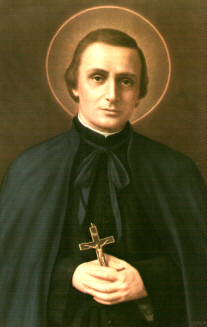St Peter Chanel, St Louis de Montfort, St Gianna Beretta Mola and St George

Peter Chanel was born in 1804 near Cras in France. His parents were peasants. His parish priest, the Abbe Trompier, took him on as a pupil because he was so bright and very devout. Peter went to the local seminary, was ordained, and rebuilt the very run-down parish of Croizet in three years. He then joined the Marist missionaries which had been recently founded by Jean Colin at Lyon. He dreamt of being sent abroad but instead worked for five years at the seminary of Belley.
Finally in 1836 he was sent to the South Pacific Islands. Together with a laybrother and an English laymen, Thomas Boog, they settled on Futuna, near Fiji. Cannibalism had only recently been banned on the island by the ruler Niuliki.
At first they were warmly welcomed, but after Peter had worked with the sick and learnt some of the local language, Niuliki became jealous. When his son asked to be baptised with some others, he became was so angry he sent a group of warriors to kill Peter, while his companions were away. They clubbed him to death and cut up his body with knives and axes.
In spite of this, many of the islanders remained faithful to the teaching they had received from Peter Chanel. One said: "He loves us. He does what he teaches. He forgives his enemies. His teaching is good."
Just a year later the whole island became Christian. Peter Chanel was canonised in 1954 by Pope Pius XII.
St Louis de Montfort
Priest, writer and founder. St Louis-Marie is perhaps most famously known for his prayer of entrustment to Our Lady, 'Totus Tuus ego sum,' which means, 'I am all yours.' Saint Pope John Paul II took the phrase 'Totus Tuus' as his episcopal motto.
Born in Montfort, Brittany, on 31 January 1673, St Louis-Marie had a strong devotion to the Blessed Sacrament as a child, and was also intimately devoted to the Blessed Virgin, especially through the Rosary. He took the name Marie at his confirmation. He showed a love for the poor while he was at school and joined a society of young men who ministered to the poor and the sick on school holidays. When he was 19, he walked 130 miles to Paris to study theology, gave all he had to the poor that he met along the way and made a vow to live only on alms.
He went to the local seminary and after his ordination at 27, served as a hospital chaplain.
St Louis-Marie discovered his great gift for preaching at the age of 32, and committed himself to it for the rest of his life. He met with such great success that he often drew crowds of thousands to hear his sermons in which he encouraged frequent communion and devotion to Mary.
But he also met with opposition, especially from the Jansenists. Much of France including many bishops, was influenced by this heresy. For a time he was barred from preaching in some dioceses. He was even poisoned by Jansenists in La Rochelle, but survived, though he suffered ill health after. While recuperating from the effects of the poisoning, he wrote the masterpiece of Marian piety, 'True Devotion to the Blessed Virgin', which he correctly prophesied would be hidden by the devil for a time. His seminal work was discovered 200 years after his death.
St Louis wrote several more classic Catholic titles and influenced several popes.
In 1715 St Louis-Marie founded two congregations: the Daughters of Divine Wisdom - which tended to the sick in hospitals and the education of poor girls, and the Company of Mary, missionaries devoted to preaching and to spreading devotion to Mary. There is now a third congregation: the Brothers of St Gabriel, who are part of the Montfortian family. They are an order of teaching brothers.
St Louis died on this day, 28 April 1716. He was 43.
St Louis was canonised by Pope Pius XII on July 20, 1947. A 'founders statue' created by Giacomo Parisini can be seen in an upper niche of the south nave of Saint Peter's Basilica.
and St Gianna Beretta Mola
www.indcatholicnews.com/news/8228
and St George
(Moved this year because his usual feast was in Easter week) See: www.indcatholicnews.com/editsaint/118












